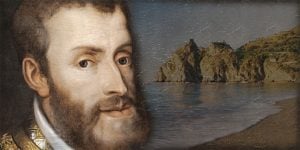On the 20th August 1535, after three long days of navigation, Charles V, emperor of the Holy Roman Empire, landed at Trapani. This was the beginning of the trip that would take him, as it will take us, on a voyage to the interior of Sicily. The city of Trapani had around 15,000 inhabitants and was known as the key to the kingdom. The port was full of people, businesses and commercial and military exchanges. Walking in the zone, we can still hear the noise of a port in full swing and the soul of a rich and vital city. The emperor remained for many days and left many marks of his stay. Let’s visit the Pepoli Palace, the place where our protagonist stayed, and the Cathedral, where the confirmation of privileges to the community of Trapani, and to single individuals, took place.
Leaving Trapani, Charles V reached Alcamo, a feudal city where he spent two nights in the impressive 14th century castle. He then left Alcamo to go to Monreale, a small town of 4,000 inhabitants, centered around the abbey and the Cathedral, with its outstanding mosaics and architecturally important apse.
This stop was to prepare him for his arrival in Palermo. The emperor’s triumphal entry into the city happened through the medieval Porta Nuova, which was decorated for the occasion with garlands and writings that celebrated the king and his military victories. Let’s follow the walk: passing Porta Nuova, we go forward to Vittorio Emanuele Street, until we reach the Cathedral. We can imagine the red and yellow drapes that adorned the noble residences which were decorated for the occasion. At the height of the church of Sant’Antonio abbot, the procession progressed towards the heart of the merchant city to St. Francis Square, the fulcrum of this magnificent ceremony.
The building that welcomed him was the spanish Palazzo Ajutamicristo, among the most sumptuous buildings in the city. During the Palermitan days there were many political engagements. Charles V lived as a Sicilian, he visited the monuments that he wanted to see and was struck by the customs of a seductive and cosmopolitan city that participated in merry-go-rounds, tournaments and shows, which alternated with the hearings at the Steri Palace.
Happy crowds saluted him from Porta Termini and Ponte dell’Ammiraglio when he left the city following a month’s stay.
Before reaching Messina, according to the tradition, he stopped to take a bath at the spa of Termini Imerese, the therapeutic qualities of which were already well known. Let’s also grant ourselves a break as we still have a long walk ahead of us.
Reaching Messina involved either a sea voyage or crossing the mountains. The presence of pirates and the bandits along the coast forced the emperor to cross the mountains but the inconvenience of the walk was compensated by the visits to the centers of the Madonies and Polizzi and he ventured into the Petralies and Gangi, where he was welcomed by the people of those places.
His visit to the convent of Gangi Vecchio is commemorated by a coat of imperial arms, placed at the main entrance. Let’s stop to photograph it and to immortalize his and our presence.
At Troina, a small and prestigious city, it is said that three horse riders crossed the crowded and narrow Roger Street, with some flowers and a haversack full of nougat with almonds, sesame and honey cut into small pieces, the so-called cubbaita. These were thrown to the ladies who leaned out of their balconies. Let’s taste some to recall those moments.
Charles V then progressed towards the small and prestigious town of Randazzo, stopping first at the abbey of Maniace.
Let’s go to the ancient Aragonese Royal Palace and to look at the walled window: from there the emperor greeted the rejoicing crowd pronouncing the sentence “You are all riders!”. Anybody, after him, was allowed to look out that window, so that this gesture has been immortalized in a fragment of eternity.
The imperial procession then descended along the valley of the Alcantara and near one of the little ponds, so called ‘gurne’, the emperor killed a duck. Since then this place has been known as the Gurna of the emperor. Let’s dip into the wonder of the place, and cross it with the amazement that only the nature can give.
Next stop: Taormina. It’s hard to imagine the village as it was in that time, enclosed in its medieval walls, unmissable for its beauty then and now. The way from Taormina to Messina through the steep hillsides of the Peloritani Mountains, was not simple so that “the brawny countrymen rushed to the Emperor’s aid and escorted him along the rugged cliffs of the island.” For us, it will be easier to cross the way not before having a stop at the monastery of St. Placido Calonerò (south of Messina), where the same emperor rested, probably exhausted for the arduous journey: to commemorate his stay, the monastery’s abbot ordered the construction of a bust, still existing.
We have reached the final destination of our journey, the rich town of Messina, one of the most populated Italian cities of the time: to welcome him, Polidoro Da Caravaggio and the mathematician Francesco Maurolico ordered three trionfal archs with the symbols dear to the emperor – the Concord, the Peace and the Victory – and the trionfal cars that accompanied him to Cathedral.
Our trip with the emperor Charles V ends here. Crossing the strait, he will have brought with him the happy noise of the lively population of Sicily, which succeeded in giving him a comforting joy and preparing him for imminent battles.





